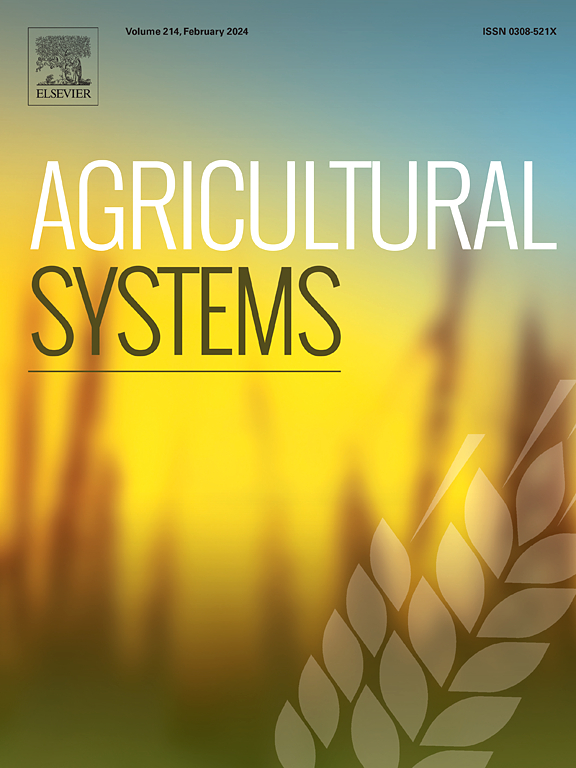Integrating crop models and machine learning for projecting climate change impacts on crops in data-limited environments
IF 6.1
1区 农林科学
Q1 AGRICULTURE, MULTIDISCIPLINARY
引用次数: 0
Abstract
Context
Accurately projecting crop yields under climate change is essential for understanding potential impacts and planning of agricultural adaptation in sub-Saharan Africa (SSA). Crop growth models and machine learning (ML) are often used, but their effectiveness is limited by data availability, precision, and geographic coverage in SSA.
Objective
This study aimed to integrate ML with a process-based crop model to produce geographically continuous gridded crop yield projections while reducing uncertainties associated with standalone ML or crop growth models. As a case study, we implemented it to project the climate change impact on water-limited potential yield of maize across SSA.
Methods
We developed an integrated system that combines ML with eco-physiological processes to estimate sowing dates and thermal times, ensuring that crop phenology is accounted for, thus improving potential rainfed yield simulations under varying environmental conditions. Random Forest and crop model-based algorithms are integrated in three steps: (i) RF1, a Random Forest model integrated with a sowing algorithm, designed to estimate the sowing window and sowing date; (ii) RF2, a Random Forest model combined with a crop model algorithm to estimate cumulative thermal time during the growing season, used to determine the timing of phenological stages; and (iii) RF3, another Random Forest model, trained based on eco-physiological principles applied in phases (i) and (ii), employed to simulate water-limited potential yield. The outcomes of the different steps of the framework under historical conditions were tested against reported data across SSA.
Results and conclusions
For maize and historical climatic conditions, the framework delivers yields which differ less than 20 % of those simulated with a crop model with high-quality inputs, in 95 % of the cases. Our approach thus shows value for generating crop yield projections in data-scarce regions under historical climate, and under future climatic conditions which already feature today somewhere in SSA and for which the framework has been trained.
Significance
Our approach can also be applied to other major food crops in SSA, under both current and climate change conditions. It allows testing the effect of adaptation of crop cultivars in terms of maturity group. Thus, it can be used for different crops and with far less data requirements compared to process-based crop models. It has the potential for significant applications in assessing climate change impacts, guiding adaptation strategies, and supporting crop breeding programmes and policymaking efforts in SSA.

整合作物模型和机器学习,在数据有限的环境中预测气候变化对作物的影响
准确预测气候变化下的作物产量对于了解撒哈拉以南非洲(SSA)农业适应的潜在影响和规划至关重要。作物生长模型和机器学习(ML)经常被使用,但它们的有效性受到SSA中数据可用性、精度和地理覆盖范围的限制。本研究旨在将机器学习与基于过程的作物模型相结合,以产生地理上连续的网格化作物产量预测,同时减少与独立机器学习或作物生长模型相关的不确定性。作为一个案例研究,我们将其应用于预测气候变化对SSA玉米限水潜力产量的影响。方法我们开发了一个集成系统,将ML与生态生理过程相结合,以估计播种日期和热时间,确保作物物候被考虑在内,从而改进不同环境条件下的潜在雨养产量模拟。随机森林算法和基于作物模型的算法分三步集成:(i) RF1,随机森林模型与播种算法集成,用于估计播种窗口和播种日期;(ii) RF2,一种结合作物模型算法估算生长季节累积热时间的随机森林模型,用于确定物候阶段的时间;(iii) RF3,另一个随机森林模型,根据(i)和(ii)阶段应用的生态生理原则进行训练,用来模拟限水潜在产量。根据跨SSA的报告数据,对历史条件下框架的不同步骤的结果进行了测试。结果和结论对于玉米和历史气候条件,在95%的情况下,该框架提供的产量与具有高质量投入的作物模型模拟的产量相差不到20%。因此,我们的方法显示了在历史气候和未来气候条件下数据稀缺地区的作物产量预测的价值,这些气候条件今天已经在SSA的某个地方出现,并且框架已经为此进行了培训。在当前和气候变化条件下,我们的方法也可以应用于SSA的其他主要粮食作物。它允许测试作物品种在成熟度组方面的适应效果。因此,它可以用于不同的作物,并且与基于过程的作物模型相比,数据需求要少得多。它在评估气候变化影响、指导适应战略以及支持SSA的作物育种计划和政策制定工作方面具有重要的应用潜力。
本文章由计算机程序翻译,如有差异,请以英文原文为准。
求助全文
约1分钟内获得全文
求助全文
来源期刊

Agricultural Systems
农林科学-农业综合
CiteScore
13.30
自引率
7.60%
发文量
174
审稿时长
30 days
期刊介绍:
Agricultural Systems is an international journal that deals with interactions - among the components of agricultural systems, among hierarchical levels of agricultural systems, between agricultural and other land use systems, and between agricultural systems and their natural, social and economic environments.
The scope includes the development and application of systems analysis methodologies in the following areas:
Systems approaches in the sustainable intensification of agriculture; pathways for sustainable intensification; crop-livestock integration; farm-level resource allocation; quantification of benefits and trade-offs at farm to landscape levels; integrative, participatory and dynamic modelling approaches for qualitative and quantitative assessments of agricultural systems and decision making;
The interactions between agricultural and non-agricultural landscapes; the multiple services of agricultural systems; food security and the environment;
Global change and adaptation science; transformational adaptations as driven by changes in climate, policy, values and attitudes influencing the design of farming systems;
Development and application of farming systems design tools and methods for impact, scenario and case study analysis; managing the complexities of dynamic agricultural systems; innovation systems and multi stakeholder arrangements that support or promote change and (or) inform policy decisions.
 求助内容:
求助内容: 应助结果提醒方式:
应助结果提醒方式:


